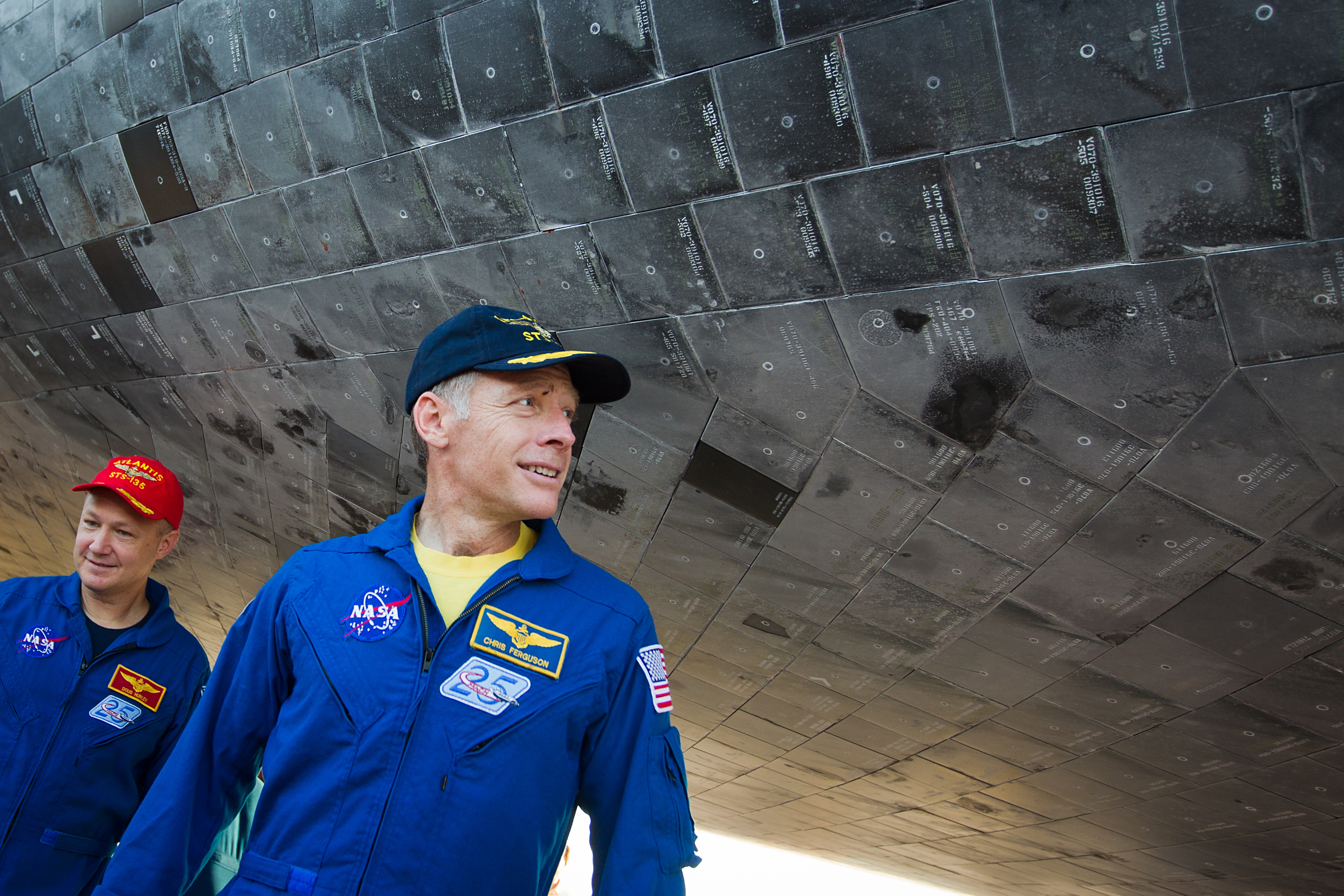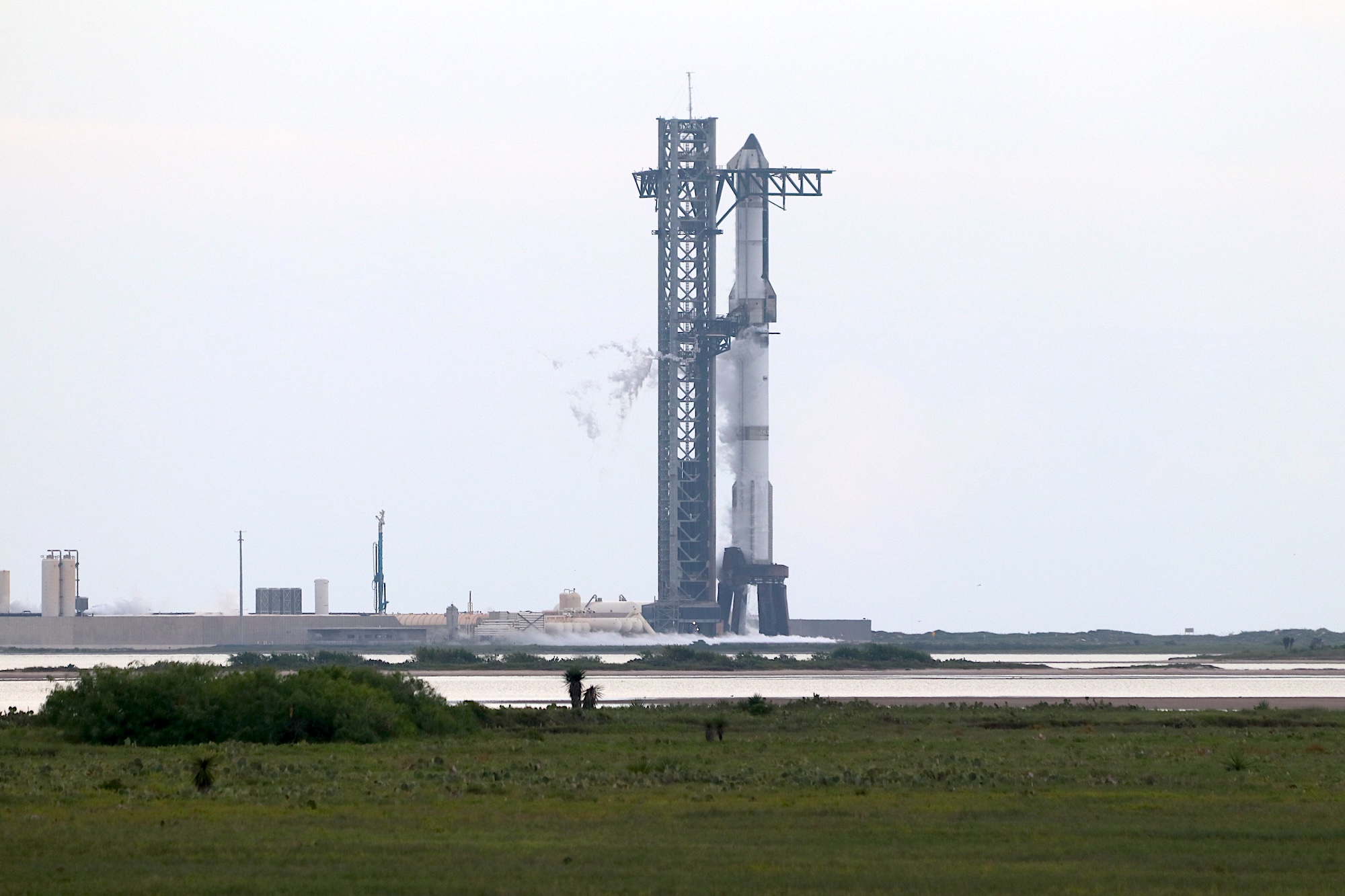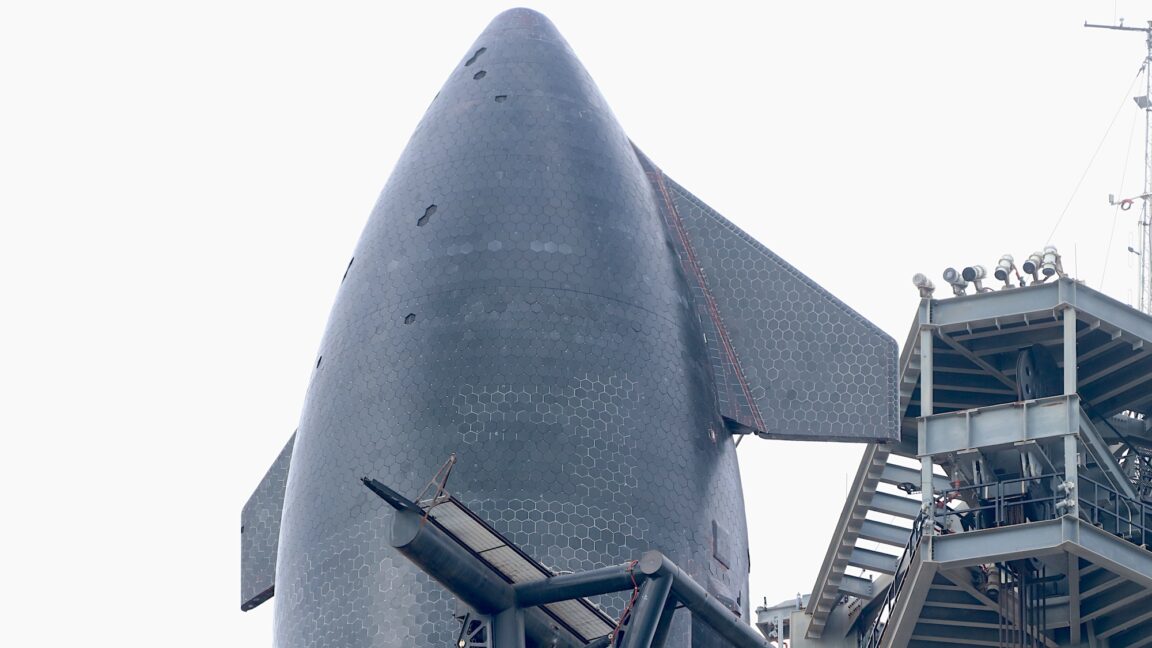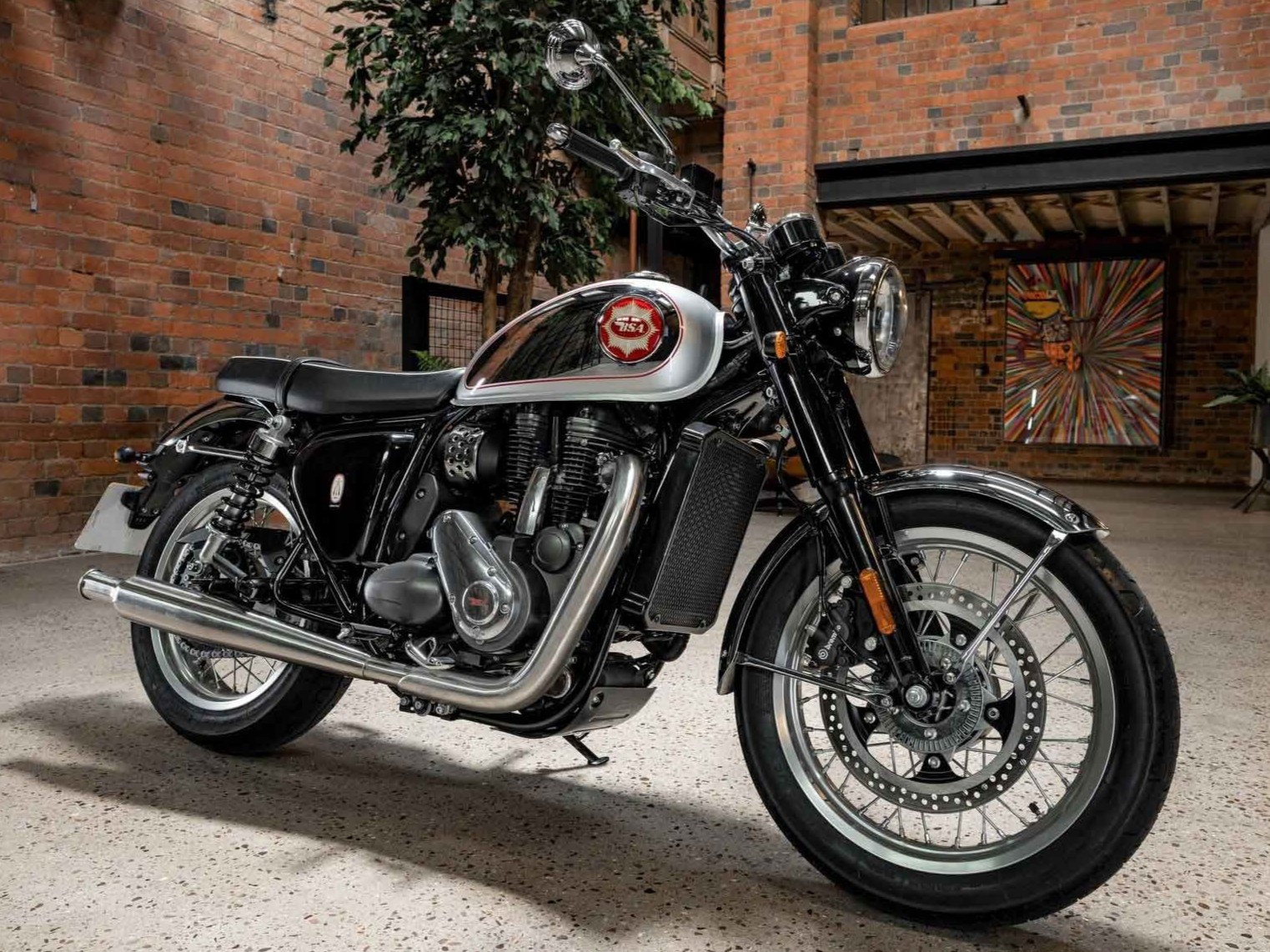STARBASE, Texas—For the third day in a row, SpaceX engineers prepared to send the company's massive Starship rocket into space Tuesday after a technical problem and bad weather grounded the test flight on two previous launch attempts.
The one-hour launch window opens at 6:30 pm CDT (7:30 pm EDT; 23:30 UTC) at SpaceX's sprawling rocket development site in South Texas, just a couple of miles north of the mouth of the Rio Grande River at the US-Mexico border.
SpaceX called off a launch attempt Sunday after detecting a leak in the plumbing that flows super-cold liquid oxygen propellant into the rocket. Technicians fixed the problem in time for another countdown 24 hours later, but the risk of lightning in the area prevented Starship from lifting off Monday evening.
Now, the Starship launch team hopes the third time is the charm. SpaceX will begin loading more than 10 million pounds of cryogenic methane and liquid oxygen propellants into the 404-foot-tall (123.1-meter) rocket about an hour before launch Tuesday.
On this flight, SpaceX aims to launch Starship halfway around the world from Texas toward a splashdown in the Indian Ocean. The three previous test flights failed before Starship reached its target. You can read more about the goals of the 10th Starship flight in our earlier story.
The failures illustrated the challenge SpaceX is trying to solve with Starship, the tallest and most powerful rocket ever built.
Don’t break the heat shield
"There are thousands of engineering challenges that remain for both the ship and the booster, but maybe the single biggest one is the reusable orbital heat shield," said Elon Musk, SpaceX's founder and CEO, on Monday.
SpaceX started off flying Starships with roughly 18,000 hexagonal tiles, each about the size of a dinner plate. These tiles were made of ceramic material, similar to the design of the heat shield tiles that flew on NASA's space shuttles. Beginning with a test flight in January, SpaceX introduced its "latest generation tiles" and added a backup layer between the tiles and Starship's underlying stainless steel structure to protect it from heat shield damage.
 A camera aboard Starship captured this view of a plasma sheath enveloping the vehicle during reentry over the Indian Ocean last year.
Credit:
SpaceX
A camera aboard Starship captured this view of a plasma sheath enveloping the vehicle during reentry over the Indian Ocean last year.
Credit:
SpaceX
Returning from space, the ship sees temperatures up to 2,600° Fahrenheit (1,430° Celsius), hot enough to melt aluminum. One of the reasons SpaceX chose stainless steel for Starship's primary structure is because of the metal's higher melting point.
Eventually, SpaceX wants to catch ships coming back from space with big mechanical arms on the launch pad, similar to the way SpaceX has shown it can recover the rocket's huge Super Heavy booster. This would allow SpaceX to theoretically stack a freshly flown ship on top of a booster right on the launch pad, then quickly refuel it and launch it again.
There are plenty of things SpaceX must prove before the company is able to do this. But SpaceX has already demonstrated it can handle some of the more obvious problems, such as repeatedly igniting the rocket's Raptor engines. The most definitive test will be SpaceX's success or failure with Starship's heat shield.
"We are confident in making a fully reusable orbital heat shield but it will require many flights, many iterations to figure out where the weak points are in the heat shield, where we need to change the design, either strengthening the tile or changing how big the gap is between tiles, or changing what’s underneath the tile," Musk said in a discussion broadcast on SpaceX's official livestream of Monday's Starship launch countdown.
The heat shield was one of the most vexing problems with NASA's space shuttle program. Thousands of tiles peeled off of the space shuttle Columbia when NASA first flew the orbiter on top of its modified 747 carrier aircraft in 1979. Tile damage was a regular occurrence throughout the shuttle program's 30-year service life, necessitating tile repairs and replacement inside the shuttle's hangar between missions.
"The space shuttle heat shield would come back essentially partially broken and would require many months of refurbishment in order to fly again," Musk said. "What we’re trying to achieve here with Starship is to have a heat shield that can be reflown immediately."
On each Starship flight this year, SpaceX has sought to test the performance of new tile designs, including metallic insulators and heat shield sections with "active cooling" to help dissipate the scorching temperatures of reentry into the atmosphere.
 NASA's space shuttle <em>Columbia</em> lost thousands of thermal protection tiles during a 1979 flight on top of the Shuttle Carrier Aircraft, a modified 747 jumbo jet.
Credit:
NASA
NASA's space shuttle <em>Columbia</em> lost thousands of thermal protection tiles during a 1979 flight on top of the Shuttle Carrier Aircraft, a modified 747 jumbo jet.
Credit:
NASA
"There are 100 different variables that we could tweak with the heat shield tiles, but the only way to know exactly what we should be adjusting is to fly repeatedly and to be able to examine the ship upon landing," Musk said.
Before SpaceX can test the heat shield repeatedly, Starship must first make it through a single flight from start to finish. It has failed to do this on all three attempts this year, following a year of progress with Starship in 2024. SpaceX guided Starship to a controlled splashdown in the Indian Ocean on several occasions last year.
“We have successfully brought the ship back through the atmosphere and achieved a soft landing multiple times, so we know that this is possible," Musk said. "But we have, in the process, shed many heat shield tiles, so we need to be able to do this without shedding heat shield tiles and do so repeatedly."
SpaceX also must make sure the launch pad's catch arms don't damage Starship's heat shield when it comes in for landing. This will only be attempted after SpaceX officials are comfortable they have solved the heat shield problem during tests over the ocean.
"We need to make sure we don’t scrape the tiles off as we slide along the chopstick arms," said Bill Riley, SpaceX's vice president of Starship engineering.
Charlie Camarda, a former NASA astronaut, engineer, and materials scientist, worked on alternatives to the shuttle's heat shield beginning in the 1970s. One of his first jobs at NASA was to demonstrate the feasibility of a heat shield for the leading edge of the space shuttle's wings that used heat pipes for active cooling.
"We were interested in looking at the more durable systems," Camarda told Ars. "The first thing I ever tested was actually an all-metallic shuttle wing leading edge, and it used heat pipes, and it was built by McDonnell Douglas. It was a competitor with the reinforced carbon-carbon, the passive leading edge system."
Ultimately, NASA went with the reinforced carbon-carbon heat shield for the leading edges of the shuttle's wings and nose cap, while the belly of the shuttle was shielded by ceramic tiles. It was one of these reinforced carbon-carbon panels that broke on the space shuttle Columbia when it was hit by a piece of foam from the shuttle's external fuel tank during launch in January 2003. The damage was undetected until the shuttle broke apart during reentry 16 days later, killing all seven astronauts onboard.
Camarda flew as a mission specialist on the next shuttle flight in 2005 after NASA developed techniques to repair a damaged heat shield in space.
"I did a lot of very early on radiant heating tests and hypersonic wind tunnel tests of this all-metallic wing leading edge, and it would basically take the heat from the lower surface and basically pump it up to the upper surface, so the entire wing leading edge would glow almost at the same temperature because it was such an effective two-phase heat transfer," Camarda said.
Camarda's work in the thermal structures branch at NASA's Langley Research Center was limited to ground testing in high-temperature wind tunnels. His designs never flew on the space shuttle.
"When I saw [SpaceX] was testing different kinds of metallic heat shields, the guys... in my old branch, were all saying, 'Wow, this is phenomenal! We wish we were young again and NASA was this vivacious, you know?' But unfortunately, we didn't get to see it."
Camarda said NASA's approach to testing is a lot different from the way SpaceX handles things.
 NASA astronaut Chris Ferguson, STS-135 commander, right, and pilot Doug Hurley, left, examine the thermal tiles of the orbiter after the space shuttle <em>Atlantis</em> landed at the Kennedy Space Center in Florida, completing STS-135, the final mission of the NASA shuttle program, on Thursday, July 21, 2011.
Credit:
Smiley N. Pool/Houston Chronicle via Getty Images
NASA astronaut Chris Ferguson, STS-135 commander, right, and pilot Doug Hurley, left, examine the thermal tiles of the orbiter after the space shuttle <em>Atlantis</em> landed at the Kennedy Space Center in Florida, completing STS-135, the final mission of the NASA shuttle program, on Thursday, July 21, 2011.
Credit:
Smiley N. Pool/Houston Chronicle via Getty Images
"It's amazing what these guys are doing, and they're doing it so rapidly, and they're testing a lot of things all at once," Camarda said. "I almost wonder if that's a smart thing to do. He's failing large. Is his vehicle that inexpensive that he could use it as a hypersonic flight test? Is it so inexpensive that he could afford to do that?
"At a research center, we had such limited budgets that we had to scrimp and save every little thing," Camarda said. "So, we would take a building block approach, and never be so bold as to do this very large test with multiple hundreds of changes. It's crazy."
The elephant in the room
SpaceX has blamed Starship's setbacks this year on fuel leaks and an engine malfunction. Apart from the program's in-flight failures, another Starship exploded during a ground test in June when a nitrogen tank failed.
Elon Musk didn't mention any of this when he appeared for roughly 20 minutes on SpaceX's live webcast Monday. Musk originally planned to provide a "technical update" on the X Spaces platform Sunday. In this format, Musk presumably could have answered questions from members of the space press corps and space enthusiasts hungry for details not just on the promise of a rocket as potentially revolutionary as Starship, but the obstacles SpaceX must overcome to make it a reality.
But SpaceX canceled the event without explanation. Instead, Musk appeared on SpaceX's official prelaunch livestream. Most of the discussion centered not on detailed technical updates, but on familiar Musk talking points: making humanity a multi-planet species, and why a rocket like Starship is necessary to make it happen.
After the heat shield, one of the next big test objectives for the Starship program will be in-orbit refueling. This is a crucial prerequisite for any Starship flights that travel into deep space. SpaceX's gigantic rocket is designed to haul up to 150 metric tons of payload into low-Earth orbit, but it can't go any farther without a recharge of its cryogenic propellant tanks.
This, like so much of the privately developed Starship program, is something that's never been done in space before. Musk said this is something he "hopes to demonstrate next year."
 SpaceX's Super Heavy booster and Starship upper stage stand fully fueled for launch Monday, moments before officials scrubbed the countdown due to bad weather.
Credit:
Stephen Clark/Ars Technica
SpaceX's Super Heavy booster and Starship upper stage stand fully fueled for launch Monday, moments before officials scrubbed the countdown due to bad weather.
Credit:
Stephen Clark/Ars Technica
But the schedule is fuzzy. Musk has recently claimed SpaceX will send its first uncrewed Starships to Mars next year, too. That won't happen without acing orbital refueling, something that NASA officials believe will likely take multiple tries to master.
Why is NASA interested in Starship refueling? The US space agency has more than $4 billion in contracts with SpaceX to develop a human-rated version of Starship that can land astronauts on the Moon. With these contracts, NASA is counting on Starship being ready to deliver a crew to the lunar surface before China.
The Moon was conspicuously absent from Musk's discussion Monday. He said the word "Mars" at least 13 times, but didn't mention the Moon at all. During his previous presentation on Starship in May, he devoted just 40 seconds of a 40-minute talk to the Moon.
This is notable, but not a surprise. Musk has called the Moon a "distraction" and in January wrote on X that SpaceX is "going straight to Mars." Even before his falling out with President Donald Trump this summer, Musk told Ars in May that the Artemis program's "ambitions are too low."
"We should be going 1,000 times farther, and going to Mars," Musk said at the time.
Meanwhile, NASA's acting administrator, Sean Duffy, continues to reiterate the agency's goal of landing astronauts on the Moon with Starship on the Artemis III mission in 2027. Duffy, who also serves as the secretary of transportation, said last month he was assured by SpaceX President Gwynne Shotwell that the company is on pace with the Starship lander.
"They said if there's a hold-up for Artemis III, it's not going to be them," Duffy said.
But it's impossible to escape the tension between the government's goals in space and those of SpaceX. Maybe a successful Starship test flight would help break the ice.

 "Foamy!" Much of the pleasure from beer comes from a nice thick head of foam.
Credit:
20th Century Fox Television
"Foamy!" Much of the pleasure from beer comes from a nice thick head of foam.
Credit:
20th Century Fox Television



















